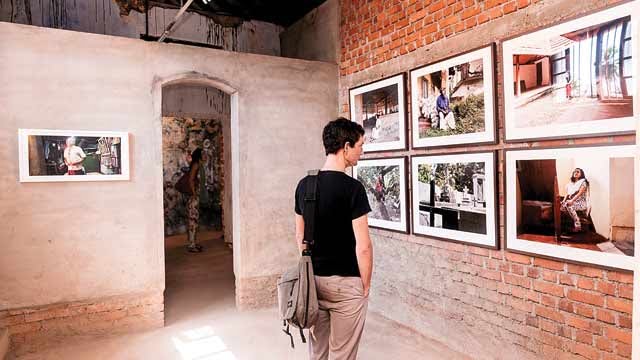
Artists are a mobile lot these days. Later this month, Priyesh Trivedi, the young, Mumbai-based animation artist best known for his ironical reworking of the Adarsh Balak posters of the 1980s and 1990s, will be off to London where he’ll live for nearly three months as part of Gasworks Gallery’s acclaimed international residency programme.
In March-April, Trivedi was in Pune to take part in Identity of Space, a residency with five Indian and five foreign artists at TIFA Working Studios, a new gallery/collaborative working space located in an abandoned Art Deco hotel.
Then again in July-August 2015, he was in the French city of Nantes, as part of Asie Riderz, a unique residency-cum-public art project where Asian artists were invited to create art on a barge that plied along the Canal Saint-Felix. That year, Trivedi took part in another art residency, East West, held at NIV Art Centre in Delhi which brought together 16 artists, a mix of nationalities – Indian, French, German, Afghan, Japanese and South Korean.
Trivedi’s schedule, a little hectic perhaps, is not an exception among young artists today — for many of whom art residencies are a part of the annual calendar.
“Residencies play a very important role in the development of art practices today,” says
Krupa Makhija, who spent three months last year at Dufftown, Scotland – home to single malt brand Glenfiddich – after being selected to be part of the company’s Artists in Residence programme.
“The art scene is not what it used to be earlier, where after you lived and worked in one place and stuck to one discipline. Now there are no limits of medium, discipline or practices. In such a scenario, residencies can act like a window. They expose you to a different environment, to different artists who come from different backgrounds; the conversations that happen as a result are very important.”
Most of these residencies, like the Glenfiddich or Gasworks, are prestigious affairs advertised through open calls, to which artists send in applications in the thousands, and the recipients are carefully selected by a panel of experts. In both cases, it is the organiser of the residency programme that pays for the artist’s travel, boarding and loading, material for creating art, and even a provision, in some cases, for an exhibition at the end.
But not all residencies are so generous. Kolkata-based artist Sumantra Mukherjee who was at the Het Wilde Weten residency in Rotterdam had to part pay his way. But at the end of the three months there, he’d put together 550 sketches of the Dutch countryside which were then compiled into a book titled Tourist Visa published by a local art publication studio.
As Trivedi says, it’s all about “building connections in the long-term”, or simply “making friends with like-minded people”.
In India, for a long time, it was only Khoj’s Delhi space which offered residencies – indeed, many of the current big name artists, starting with Subodh Gupta, have been part of residencies there.
But now many have jumped into the act – NIV Art Centre in Delhi opened in 2013 and TIFA, Pune, which began offering residencies sometime in 2014. Then, there’s the magnificently located Pepper House, a large, open plan former spice warehouse in Kochi which offers residencies both independently and in conjunction with the Kochi Muziris Biennale.
Studio space is free here, says Isaac Alexander, Pepper House’s owner, but artists have to arrange for food and other logistics. Also it helps if the artist proposes to work with the local community.
Mumbai has WAA (What About Art) Studio which offers a paid residency; ICAC, or International Creative Art Centre’s residency in Dehegam near Ahmedabad is one where artists need to pay too. Goa has two such centres – Sunaparanta Centre for Arts and the more recent Heritage Hotel Art Spaces, an artist-run studio space co-founded by performance artist Nikhil Chopra.
Clearly, for artists, the world is their oyster.
[Source:- DNA]



